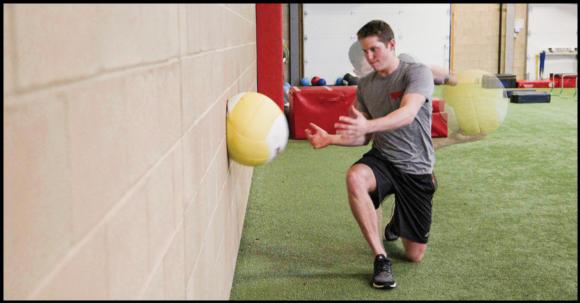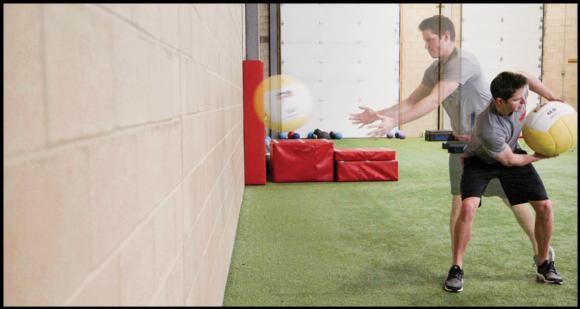Rotational Throws
This is an excerpt from New Functional Training for Sports 2nd Edition With HKPropel Online Video by Michael Boyle.
Rotational throws are the best technique for developing power in the core and hip muscles. These exercises are particularly good for hockey, golf, tennis, baseball, and any other sport that requires explosive rotary action. Medicine ball throws develop hip power by teaching the athlete to better utilize hip internal and external rotation to draw power from the ground. The goal is not torso rotation but rather powerful hip rotation. The objective is to learn to transfer ground forces through a relatively stiff and stable core.
Much like some of our other core exercises, we progress from either tall kneeling or half kneeling to standing throws and eventually to stepping throws. The lunge position is difficult for medicine ball throws, so we often progress from a kneeling variation directly to a standing variation, skipping the lunge position.
Half-Kneeling Side-Twist Throw
Progression 1
As with our other core progressions, for most beginners we start with a half-kneeling version of the side-twist throw (see figure 7.28). This will be phase 1 in most of our athlete programs. As mentioned before, physical therapist Gray Cook popularized the idea of eliminating joints for teaching purposes. The half-kneeling position teaches hip rotation in the throws by effectively taking out the knees and ankles. By having the inside (closest to the wall) knee up, the athlete or client is forced to use the hips and the kneeling (back side) glute.
We teach a long-arm, long-lever throw with the inside hand under the ball and the outside hand behind the ball. Make sure this is a long-lever rotation and not a push. Encourage the mental link to a shot or swing to teach the use of the long lever arm, and watch for athletes reverting to more of a push. Also, make the clients aware it will feel awkward on their nondominant side.
- Begin while half kneeling in a short lunge position, two to three feet (.6 to .9 m) from the wall; shoulders are perpendicular to the wall.
- The arms are long, with the front hand under the ball and the back hand behind.
- Think about throwing from the back knee and hip with some hip "pop."

Medicine ball half-kneeling side-twist throw.
Standing Side-Twist Throw
Progression 2
As mentioned earlier, we skip the lunge-position throws for a very simple logistical reason. Our athletes and clients struggled to maintain the lunge position and to focus on the throw itself, so now we simply skip to standing. In certain cases we start younger or older athletes or clients immediately in standing (see figure 7.29). For high school and college athletes, we stick with a progression from half kneeling to standing to stepping, but with middle school kids and our adults, we begin in standing and simply say, "Throw the ball as hard as you can." This emphasis on a gross motor pattern often overcomes some technical hurdles. In much the same way, older clients may be too stiff through the hips and core to benefit from the half-kneeling position the way an athlete does and may also start in standing. Remember, progressions are fluid suggestions, not rigid rules.

Medicine ball standing side-twist throw.
Side-Twist Throw With Step
Progression 3
The next step in the progression is to add movement to the throw. In progression 3, step toward the wall with the front foot to increase the force being generated from the back foot. Emphasis is on shifting weight from the back foot to the front. All other aspects of the side throw remain the same.
Two-Step Side-Twist Throw
Progression 4
In our fourth progression, the athlete takes two steps toward the wall. Obviously the client or athlete now needs to be farther away from the wall. The two-step throw is more aggressive and violent and really mimics the actions of shooting on the move. The two-step throw also places greater stress on the front foot and hip.
Learn more about New Functional Training for Sports.
More Excerpts From New Functional Training for Sports 2nd Edition With HKPropel Online VideoSHOP

Get the latest insights with regular newsletters, plus periodic product information and special insider offers.
JOIN NOW


